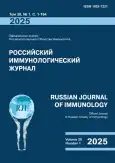Dynamics of VEGF and TGF-β indices in lacrimal fluid as a predictor of corneal transplant rejection
- 作者: Bystrov A.M.1, Kuznetzov A.A.1
-
隶属关系:
- Chelyabinsk Regional Clinical Hospital
- 期: 卷 28, 编号 1 (2025)
- 页面: 103-108
- 栏目: SHORT COMMUNICATIONS
- URL: https://journal-vniispk.ru/1028-7221/article/view/277348
- DOI: https://doi.org/10.46235/1028-7221-16977-DOV
- ID: 277348
如何引用文章
全文:
详细
Graft rejection is the most common cause of corneal transplant failure. Despite the fact that the cornea is an immunoprivileged organ, corneal transplant rejection is still a pressing problem. Vascularization plays one of the key roles in triggering corneal transplant rejection. Depending on the condition of the recipient’s tissue bed, keratoplasty may be classified into “high-risk” and “low-risk” rejection. In the first case, the mechanisms of immune privilege and tolerance are disturbed. In the case of “low-risk” keratoplasty, transplantation occurs at avascular and non-inflamed bed, which is a more favorable prognostic option. The aim of our study was to evaluate the levels of vascular endothelial growth factor (VEGF) and transforming growth factor â (TGF- â) in the tear fluid of patients before and after penetrating keratoplasty.
42 patients (84 eyes) participated in the study, including 28 women (61.54%) and 14 men (38.46%) aged from 31 to 65 years, the average age was 53.1±4.38 years. Patients were divided into “high-risk” and “low-risk” groups depending on their medical history and objective clinical pattern. The levels of cytokines in the tear fluid were determined using a multiplex analysis on a Luminex Magpix 100 immunoanalyzer (USA) using a Bio-Rad multiplex analysis test system (USA) over time before surgical treatment and after 1 and 6 months of the postoperative period.
The study showed an increased concentration of vascular endothelial growth factor and, conversely, a decrease in the concentration of transforming growth factor â in patients at high risk. The opposite picture, if compared to the indices of healthy controls, was observed in patients from the “low-risk” group, where low background concentrations of vascular endothelial growth factor and high levels of transforming growth factor â were determined. This finding suggests preservation of immune tolerance at the internal media of the eye, maintaining a balance of neovascularization, thus being associated with low risk of graft rejection.
The risks of more frequent corneal transplant rejection as the concentration of immunosuppressive factors (e.g., TGF) decreases, and, vice versa, the risks increase with changing levels of vasoform cytokines that promote corneal neovascularization.
作者简介
A. Bystrov
Chelyabinsk Regional Clinical Hospital
编辑信件的主要联系方式.
Email: highvision@bk.ru
Clinical Ophtalmologist, Ophthalmology Department No. 1
俄罗斯联邦, ChelyabinskA. Kuznetzov
Chelyabinsk Regional Clinical Hospital
Email: highvision@bk.ru
PhD (Medicine), Head, Ophthalmology Center
俄罗斯联邦, Chelyabinsk参考
- Ambati B.K., Nozaki M., Singh N., Takeda A., Jani P.D., Suthar T., Ambati J. Corneal avascularity is due to soluble VEGF receptor-1. Nature, 2006, Vol. 443, no. 7114, pp. 993-997.
- Bock F., Maruyama K., Regenfuss B., Hos D., Steven P., Heindl L.M., Cursiefen C. Novel anti (lymph) angiogenic treatment strategies for corneal and ocular surface diseases. Prog. Retin. Eye Res., 2013, Vol. 37, pp. 89-124.
- Cursiefen C., Maruyama K., Bock F., Saban D., Sadrai Z., Lawler J., Masli S. Thrombospondin 1 inhibits inflammatory lymphangiogenesis by CD36 ligation on monocytes. J. Exp. Med., 2011, Vol. 208, no. 5, pp. 1083-1092.
- Dohlman T.H., Omoto M., Hua J., Stevenson W., Lee S.M., Chauhan S.K., Dana R. VEGF-trap aflibercept significantly improves long-term graft survival in high-risk corneal transplantation. Transplantation, 2015, Vol. 99, no. 4, pp. 678-686.
- Hori J., Yamaguchi T., Keino H., Hamrah P., Maruyama K. Immune privilege in corneal transplantation. Prog. Retin. Eye Res., 2019, Vol. 72, 100758. doi: 10.1016/j.preteyeres. 2019.04.002.
- Janyst M., Kaleta B., Janyst K., Zagożdżon R., Kozlowska E., Lasek W. Comparative study of immunomodulatory agents to induce human T regulatory (Treg) cells: preferential Treg-stimulatory effect of prednisolone and rapamycin. Arch. Immunol. Ther. Exp., 2020, Vol. 68, no. 4, 20. doi: 10.1007/s00005-020-00582-6.
- Maharana P.K., Mandal S., Kaweri L., Sahay P., Lata S., Asif M.I., Sharma N. Immunopathogenesis of corneal graft rejection. Ind. J. Ophthalmol., 2023, Vol. 5, no. 71, pp. 1733-1738.
- Major J., Foroncewicz B., Szaflik J.P., Mucha K. Immunology and donor-specific antibodies in corneal transplantation. Arch. Immunol. Ther. Exp., 2021, Vol. 69, no. 1, 32. doi: 10.1007/s00005-021-00636-3.
- Massagué J., Sheppard D. TGF- signaling in health and disease. Cell, 2023, Vol. 186, no. 19, pp. 4007-4037.
- Oka M., Iwata C., Suzuki H.I., Kiyono K., Morishita Y., Watabe T., Miyazono K. Inhibition of endogenous TGF-beta signaling enhances lymphangiogenesis. Blood, 2008, Vol. 111, no. 9, pp. 4571-4579.
- Salabarria A.C., Braun G., Heykants M., Koch M., Reuten R., Mahabir E., Bock F. Local VEGF-A blockade modulates the microenvironment of the corneal graft bed. Am. J. Transplant., 2019, Vol. 19, no. 9, pp. 2446-2456.
- Schoenberg A., Hamdorf M., Bock F. Immunomodulatory strategies targeting dendritic cells to improve corneal graft survival. J. Clin. Med., 2020, Vol. 9, no. 5, 1280. doi: 10.3390/jcm9051280.
- Singh R.B., Marmalidou A., Amouzegar A., Chen Y., Dana R. Animal models of high-risk corneal transplantation: A comprehensive review. Exp. Eye Res., 2020, Vol. 9, no. 198, pp. 108-122.
- Taylor A.W. Ocular immune privilege and transplantation. Front. Immunol., 2016, Vol. 7, 37. doi: 10.3389/fimmu.2016.00037.
- Wilson S.E. TGF beta -1, -2 and -3 in the modulation of fibrosis in the cornea and other organs. Exp. Eye Res., 2021, Vol. 207, 108594. doi: 10.1016/j.exer.2021.108594.
补充文件









